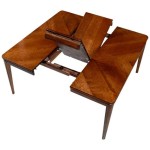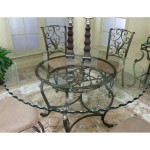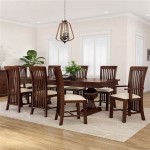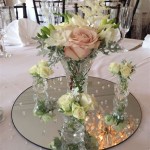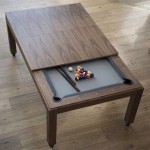Selecting the Ideal Dining Table for Four People
Choosing the right dining table is a significant decision for any household, impacting not only meal times but also the overall aesthetic and functionality of the dining space. A dining table designed for four people represents a versatile option, suitable for smaller families, couples who frequently entertain, or individuals seeking a well-proportioned piece for their dining area. The selection process involves careful consideration of various factors, including size, shape, material, style, and spatial constraints. This article provides a comprehensive guide to navigating these considerations, assisting in the selection of a dining table that perfectly complements individual needs and preferences.
Understanding Size and Shape Considerations
The dimensions of a dining table are paramount, particularly when accommodating four individuals. A generally accepted guideline suggests allocating approximately 24 inches of width per person at the table. This translates to a minimum table width of 48 inches for comfortable seating. However, this is merely a baseline, and additional space may be desired based on the size of dinnerware, centerpieces, and serving dishes. Consider allowing for a comfortable reaching distance to the table's center for all diners. A practical approach involves physically measuring the available dining space, factoring in clearance for chairs to be pulled out and guests to move around the table easily. Aim for at least 36 inches of clearance between the table and walls or other furniture. Smaller spaces benefit from tables that can be extended or folded when not in full use.
The shape of the dining table also plays a crucial role in both functionality and aesthetics. The most common shapes include rectangular, square, round, and oval. Rectangular tables are often favored for their versatility and ability to accommodate varying numbers of guests. A rectangular table for four typically measures around 48-60 inches in length and 30-36 inches in width. This shape is well-suited for longer, narrower dining spaces. Square tables, ideally measuring around 36-48 inches on each side, are a good fit for smaller, square-shaped rooms, promoting intimacy and conversation. Round tables, typically 42-48 inches in diameter for four people, also encourage conversation and are suitable for smaller spaces, as they lack sharp corners. Oval tables offer a blend of the benefits of rectangular and round tables, providing ample surface area while retaining a softer, less formal appearance. They work well in both rectangular and square rooms, offering flexibility in seating arrangements.
When selecting the shape, consider the room's architecture and flow. In a galley kitchen or a dining area adjacent to a hallway, a round or oval table may be preferable to avoid sharp corners that could obstruct movement. In a more open-plan living space, a rectangular table can help define the dining area and create a sense of separation. Ultimately, the ideal shape depends on the specific dimensions of the space and the desired atmosphere.
Exploring Material Options and Their Impact on Style
The material of a dining table significantly influences its durability, maintenance requirements, and overall style. Common materials include wood, glass, metal, and composite materials such as laminate and MDF (Medium Density Fiberboard). Each material offers distinct advantages and disadvantages, impacting the table's price point, longevity, and aesthetic appeal.
Wood remains a popular choice for dining tables due to its natural beauty, warmth, and durability. Hardwoods such as oak, maple, and walnut are particularly prized for their strength and resistance to scratches and dents. Softwoods like pine are more affordable but may require more careful maintenance. The finish applied to the wood, whether a stain, varnish, or paint, further affects its appearance and protection. A natural wood finish highlights the grain and texture of the wood, while a painted finish offers a wider range of color options. Wooden tables suit a variety of styles, from traditional and rustic to modern and minimalist, depending on the type of wood, finish, and design details.
Glass-topped dining tables offer a contemporary and elegant look, creating an illusion of spaciousness and allowing natural light to flow through the room. Tempered glass is the preferred choice for safety and durability. Glass tables are relatively easy to clean and maintain, but they can be susceptible to scratches and fingerprints. The base of a glass-topped table can be made of metal, wood, or a combination of both, offering versatility in design. Metal bases, often made of steel or iron, provide a sleek and industrial aesthetic.
Metal dining tables are known for their strength and durability, making them suitable for high-traffic areas. Metal can be used for the entire table or as a frame or accent. Powder-coated metal finishes offer resistance to scratches and rust. Metal tables often have a modern or industrial style, but they can also be incorporated into more traditional designs with the addition of wooden or upholstered elements.
Composite materials like laminate and MDF offer affordability and a wide range of design options. Laminate tables are covered with a thin layer of plastic or paper that can mimic the appearance of wood, stone, or other materials. MDF is a type of engineered wood that is more stable and less prone to warping than solid wood. Composite tables are relatively easy to clean and maintain, but they may not be as durable as solid wood or metal tables. They are a good option for budget-conscious consumers seeking a stylish and functional dining table.
When selecting a material, consider the overall style of the dining room and the desired level of maintenance. For families with young children, a durable and easy-to-clean material like laminate or a hardwood with a protective finish may be preferable. For a more formal dining room, a glass-topped table with a metal or wooden base can create an elegant and sophisticated atmosphere.
Matching Style to the Dining Space and Personal Preferences
The style of the dining table should complement the existing décor of the dining space and reflect personal preferences. Considering the overall aesthetic of the room helps to ensure that the new dining table seamlessly integrates with the surrounding furniture and accessories. Understanding the dominant style of the room will narrow down suitable choices and create a harmonious visual effect.
For a traditional dining room, a wooden dining table with ornate details, such as carved legs or a decorative apron, may be appropriate. Rich wood finishes, such as cherry or mahogany, can enhance the formal atmosphere. Traditional dining tables often feature a rectangular or oval shape, providing ample space for formal dining arrangements. Consider pairing the table with upholstered dining chairs to complete the look.
In a modern dining room, a sleek and minimalist dining table with clean lines and a simple silhouette may be more suitable. Glass-topped tables with metal bases or wooden tables with a light or natural finish can create a contemporary feel. Round or square tables can work well in modern spaces, promoting a sense of intimacy and conversation. Pair the table with modern dining chairs made of metal, plastic, or leather to complement the streamlined aesthetic.
For a rustic or farmhouse-style dining room, a wooden dining table with a distressed finish or a reclaimed wood tabletop can add character and charm. A rectangular table with sturdy legs and a natural wood finish can evoke a sense of warmth and authenticity. Consider pairing the table with wooden chairs or benches to complete the rustic look. Adding vintage accessories, such as mason jar lighting fixtures or galvanized metal accents, can further enhance the farmhouse aesthetic.
In an eclectic dining room, there is more freedom to mix and match different styles and materials. A dining table with a unique design or an unexpected combination of materials can add personality and visual interest to the space. Consider pairing a vintage dining table with modern dining chairs or a glass-topped table with rustic wooden legs. Experiment with different colors, textures, and patterns to create a one-of-a-kind dining space that reflects individual tastes and preferences.
Ultimately, the style of the dining table should reflect personal taste and create a welcoming and comfortable atmosphere for dining and entertaining. Consider the overall mood and ambiance that is desired for the dining space and choose a table that helps to achieve that vision. Paying attention to details such as the shape, material, finish, and design of the table can make a significant difference in the overall look and feel of the dining room.
Beyond the practical aspects of size, shape, and material, consider the emotional connection to the dining table. This is a piece of furniture that will likely witness countless meals, conversations, and gatherings. Choosing a table that resonates with personal style and values ensures that it not only serves its functional purpose but also contributes to the overall enjoyment of the dining experience.

Four Seater Dining Set

The Best Dining Table Sets For 4 People
Folding Dining Table Household Small Sized Movable Rectangular And Chair Combination Multi Functional For 4 People 6 Supplementary Order Needed Ee Singapore

4 Seater Cannes Dining Table Chair Set

Finmind 39 4 Inches Square Dining Table For 2 People Chairs Not Included

Sascha 4 Seater Round Dining Table Marble Dunelm

Angela Tokyo Sheraton Solid Wood Japanese Dining Table Bench

Bestier Rustic Brown Wood 70 In 4 Heavy Duty Metal Legs Dining Table With Storage Rack Seats 6 8 Usthdczus K400278b Rstbt M The Home

Mobel Oak Small Dining Table Seats 4 Duck Barn Interiors

31 5 Japandi Dining Table Round 4 Seater With Sintered Stone Top Homary

